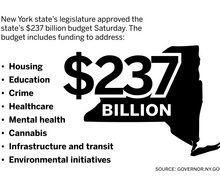17 central New York women are using their art to smash the patriarchy
Courtesy of Mary Giehl
Mary Giehl's "Adopt Me" is one of the displays at the "Seen and Heard" exhibit that shows modern women's issues. The exhibit will be at the ArtRage Gallery starting Saturday.
Three years ago, Mary Giehl strung hundreds of rice bowls from thousands of red threads hanging from the ceiling of the Everson Museum of Art. A 9-year-old boy came up to her, standing eye level with the bowls.
“He said to me, ‘when I look down below, and I look up, I feel like I’m under the sea,’” she said. “It was the most amazing thing for the 9-year-old to do.”
Those red threads and rice bowls were the main components of an installation at Giehl’s 2014 exhibit on malnutrition. Giehl’s art has always had socio-political under- and overtones. The “Rice is Life” exhibit is one of many, including her most recent group show, “Seen and Heard,” at the ArtRage Gallery.
Central New York-based women artists, including Giehl, will showcase their work in “Seen and Heard.” The exhibit will feature artistic representations of issues modern women face 100 years after women’s suffrage was written into New York state law. The exhibit will kick off with an all-are-welcome reception this Saturday from 7 to 9 p.m. at the ArtRage Gallery.
ArtRage and Everson collaborated to create the “Seen and Heard” show. At Everson, patrons can see work by artists from all over the country. ArtRage’s collection focuses on local artists.
“There are not a lot of opportunities for local artists to exhibit in Syracuse, so we thought it would be nice,” said Kimberley McCoy, ArtRage’s community engagement organizer.
McCoy said she and ArtRage are proud to use “Seen and Heard” as a way to recognize women’s activism in the central New York area and to remember that while progress has been made since New York state granted women’s suffrage, a lot of work remains to be done.
There are 17 artists showing their work in the exhibition. Among them is an artist directly from the Syracuse University campus. Gail Hoffman, a professor in the Department of Transmedia at the College of Visual and Performing Arts, has been making art for as long as she can remember. As a child, she was always drawing on any paper she could find. She developed her current art aesthetic while in graduate school, she said.
Hoffman creates surrealist environments, almost like cast-in-bronze dioramas. A girl walks on a bronze tightrope suspended over bleachers arranged as if for a bonfire. A helicopter releases a ladder into the living room of a man watching TV.
For “Seen and Heard,” Hoffman cast three girls, clad in 1950s-schoolgirl pinafore, gazing up at a woman whose head is mounted atop a rickety ladder. Created in response to the tumultuous 2016 presidential election, Hoffman’s art advocates that there is still progress that needs to be made in regard to women’s rights. The glass ceiling has yet to be broken.

Courtesy of Gail Hoffman
Giehl’s contribution to the exhibit, titled “Adopt Me,” is the fruition of a concept that’s been on her mind for years. She created some anonymous-looking dolls and some children’s clothing, a slightly unnerving display that she hopes will spread awareness for child abuse.
She said four children die each day in the United States from abuse. To combat the issue, patrons can buy a doll and an article of clothing. The profits Giehl would ordinarily make from featuring her art in a galley will go to McMahon/Ryan Child Advocacy Center.
She originally proposed the idea to a gallery now closed in Massachusetts, but it fell to the back burner in the wake of the 2012 Sandy Hook elementary school shootings.
ArtRage’s call for artists revived the idea, and the theme fit perfectly with her message. Giehl said she’s excited for the exhibit because it’s a women-supporting-women effort. At one of her other shows, she exhibited a lot of fiber pieces, and women responded and connected to it with particular intent.
“The men were just like ‘oh, yeah,’” she said. “But the women can see through that hard and time-consuming labor.”
Artist Sharon Souva feels the same way. She made a quilt representing women’s reproductive and menstrual cycles, and the Trump administration’s backtracking on progress women have achieved over their reproductive rights.
“What makes me want to take part in ‘Seen and Heard’ is the connection I feel with other women,” she said. “We have bodies that can reproduce life.”

Courtesy of Sharon Souva
But while women supporting women is certainly a big part of fourth wave feminism, artist and Hamilton College lecturer Lorena Molina urges people to remember that not all women have always had a place at the table.
Molina grew up in El Salvador during its bloody civil war, which raged from 1980 to 1992. At age 14, she fled to California with her mother and brother. Her experiences there, as well as feeling displaced after leaving her home country, have heavy influence on her work.
For the “Seen and Heard” exhibit, she submitted a video titled “Hit” that she worked on in graduate school. She is repeatedly slapped by a hand that enters and exits the frame from first person point of view. Hitting on issues including oppression and racial segregation, the video is shown on a small screen and forces the viewer to grapple with how they have been complicit with the suffering of others, themes that tie-in well with the intersectional aspect of feminism.
“Feminism for me is the ability and opportunity to be free. To be free is a luxury that not all women are granted, let alone to have the same opportunities as white men,” she said. “I’m happy to be in this exhibition, because if it happened 100 years ago, I would not have been invited to participate.”
Published on September 5, 2017 at 9:17 pm
Contact: cmrussel@syr.edu | @caseymrussell




